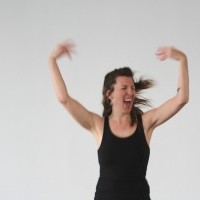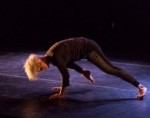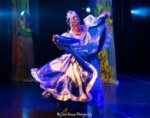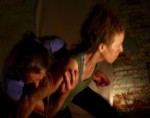
Stillness and Disruption: On Flowers Cracking Concrete, a Book by Rosemary Candelario
by Janna Meiring
“The effect of Eiko & Koma’s performances is like water eroding rock or tree roots displacing a sidewalk: the sometimes imperceptible movements of two bodies over time have a profound impact physically and emotionally on one another, their environment, and their audiences” (p. 5). In her book, Flowers Cracking Concrete: Eiko & Koma’s Asian/American Choreographies, Rosemary Candelario offers a critical analysis of the work of Eiko & Koma, a Japanese-American duo whose use of slowness, natural elements, and repeating themes can be seen as breaking through social and political structures and constructs of time.
Arriving individually in Tokyo in the late 1960s, Eiko and Koma each sought a way out of an increasingly violent student activist movement. Under the tutelage of experimental dance artist Tatsumi Hijikata, they encountered each other and a stream of other artists looking for the same. As a duo, Eiko & Koma went on to create stage, screen, site-specific, outdoor, installation, and gallery works all over the world. Their substantial collection has emerged through a sustained practice of dance as a way to examine issues that are relevant to them, and to re-imagine how to live in society.
The first half of the book is dedicated to Eiko & Koma’s early works. Candelario parallels the duo’s artistic development with in-depth cultural and political contexts that influenced how they were received in different communities. Their training in Japan, Germany, and throughout Europe included study with artists such as Hijikata, Kazuo Ohno, and Manja Chmiel, who taught in the style of Mary Wigman. After a period of travel, Eiko & Koma accepted an offer to perform in the United States, landing them in the downtown arts scene of New York City in 1976. Here they “were immersed in an active group of artists who were using their art to imagine new ways of being in society” (p. 53).
It is from all of these influences that Eiko and Koma’s distinct style began to form. In White Dance (1976), “No one moves for what seems like an eternity, and then Koma begins to carefully pick his way around and across the stage, stepping lightly on his toes and occasionally flicking his foot back with a flourish to reveal his bare buttocks through a slit in the back of his bright, red, short kimono, worn backwards” (p. 49). The duo soon became known for extreme slow motion punctuated with abrupt events of absurdity—leading to performance opportunities in both New York and San Francisco.
After settling in New York City in 1977, they premiered Fur Seal, a work in which the duo exists onstage as heavy seals on rocks, alternating with humorous “vacations” into walking, running, and jumping. American critics had a hard time interpreting this piece, eventually landing on an “alienness”[i] that made it impossible to understood, though still worthy of being admired. This sentiment, as Candelario argues, reiterates the dominant view of the time frames that limit the work of Asian-American artists as a representation of one of three worlds: “ancient,” “traditional,” or “post-nuclear.” This type of labeling ignored the fact that Japan is part of the modern world, subject to intercultural influences, including American culture and aesthetics.
The author anchors the duo in American modern and postmodern dance history, challenging the tendency to view their work as a demonstration of Japanese culture or post-nuclear survival. Candelario’s approach echoes the title of the book. She slowly and repeatedly cracks through a Eurocentric point of view that sees itself as defining American-ness. Because these patterns are still alive today, Candelario’s perspective provides an important break in how intercultural performance in the United States tends to be interpreted.
In the second half of the book, the author dives farther into the recurring themes and choreography of Eiko & Koma’s work: nature, sustained mourning, and cultural alliances. By allowing themselves the time and space to do so, these artists have exposed our deepest humanity through repetition of ideas over the course of 40 years. “Dancing-with" (p. 108) nature and expressing public mourning became central themes as they grappled with subjects such as Hiroshima and Nagasaki, refugee crises, HIV and 9/11. “Their choreography [gives] space to the bodies of the lost as well as those left behind. The audience is provided with an opportunity to powerfully witness the evidence of a great loss and to participate in the mourning of that loss,” (p. 144) Candelario writes.
Through many interfaces, their work is ultimately site-adaptive, which gives the audience a multi-layered and non-linear experience. In addition to adjusting a project to present in different spaces, they also mix, recycle, and reexamine themes, choreography, forms, and materials under different cultural or political circumstances. This continual re-examination of nature, mourning, and violence through the art of dance serves to link our struggles over time and to slowly break up old forms of thinking.
As the name of the book suggests, Eiko & Koma’s performance work has within it simultaneous stillness and disruption; there is an unseen natural power that drives a revolt against constricting structures, allowing something seemingly delicate about our human experience to appear. This book is a long-overdue articulation of the conditions and methodology that make Eiko & Koma’s work so influential, and the power of what all artists do in society over time—break up the concrete with our seemingly small movements.
Book:
Rosemary Candelario, Flowers Cracking Concrete: Eiko and Koma’s Asian/American Choreographies. Middletown, CT: Wesleyan University Press, 2016. 221 pp.
[i] p. 61 Jan Halsey, “‘Fur Seal,’ Boring but Intriguing,” Daily Democrat, August 11, 1978
By Janna Meiring
September 12, 2017










